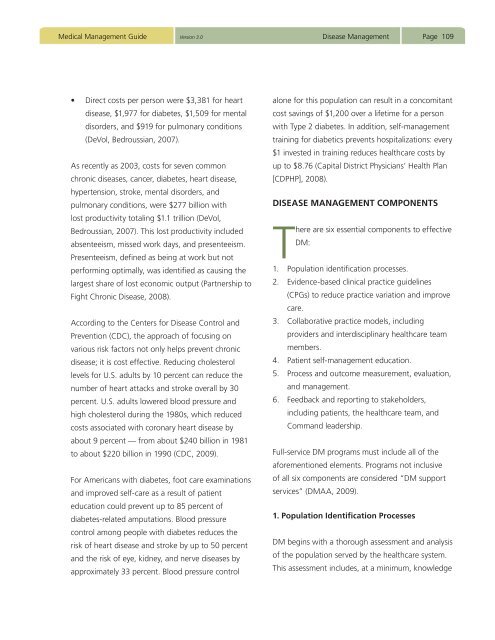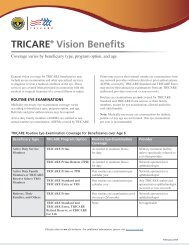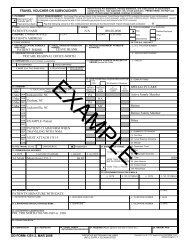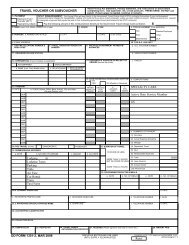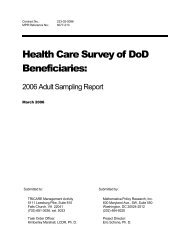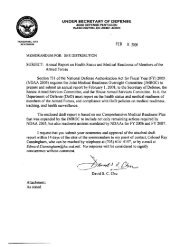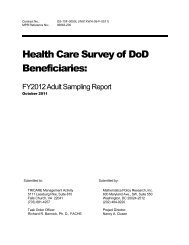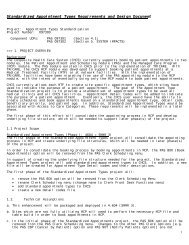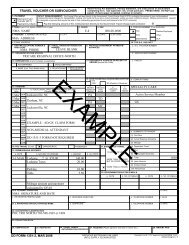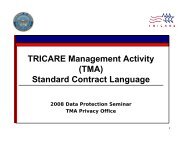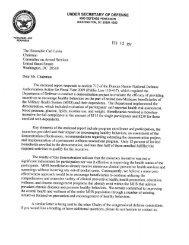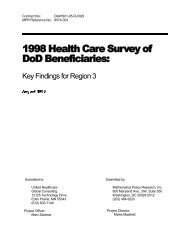Medical Management Guide, 2009, Version 3.0 - Tricare
Medical Management Guide, 2009, Version 3.0 - Tricare
Medical Management Guide, 2009, Version 3.0 - Tricare
- No tags were found...
You also want an ePaper? Increase the reach of your titles
YUMPU automatically turns print PDFs into web optimized ePapers that Google loves.
<strong>Medical</strong> <strong>Management</strong> <strong>Guide</strong><strong>Version</strong> <strong>3.0</strong>Disease <strong>Management</strong>Page 109• Direct costs per person were $3,381 for heartdisease, $1,977 for diabetes, $1,509 for mentaldisorders, and $919 for pulmonary conditions(DeVol, Bedroussian, 2007).As recently as 2003, costs for seven commonchronic diseases, cancer, diabetes, heart disease,hypertension, stroke, mental disorders, andpulmonary conditions, were $277 billion withlost productivity totaling $1.1 trillion (DeVol,Bedroussian, 2007). This lost productivity includedabsenteeism, missed work days, and presenteeism.Presenteeism, defined as being at work but notperforming optimally, was identified as causing thelargest share of lost economic output (Partnership toFight Chronic Disease, 2008).According to the Centers for Disease Control andPrevention (CDC), the approach of focusing onvarious risk factors not only helps prevent chronicdisease; it is cost effective. Reducing cholesterollevels for U.S. adults by 10 percent can reduce thenumber of heart attacks and stroke overall by 30percent. U.S. adults lowered blood pressure andhigh cholesterol during the 1980s, which reducedcosts associated with coronary heart disease byabout 9 percent — from about $240 billion in 1981to about $220 billion in 1990 (CDC, <strong>2009</strong>).For Americans with diabetes, foot care examinationsand improved self-care as a result of patienteducation could prevent up to 85 percent ofdiabetes-related amputations. Blood pressurecontrol among people with diabetes reduces therisk of heart disease and stroke by up to 50 percentand the risk of eye, kidney, and nerve diseases byapproximately 33 percent. Blood pressure controlalone for this population can result in a concomitantcost savings of $1,200 over a lifetime for a personwith Type 2 diabetes. In addition, self-managementtraining for diabetics prevents hospitalizations: every$1 invested in training reduces healthcare costs byup to $8.76 (Capital District Physicians’ Health Plan[CDPHP], 2008).DISEASE MANAGEMENT COMPONENTSThere are six essential components to effectiveDM:1. Population identification processes.2. Evidence-based clinical practice guidelines(CPGs) to reduce practice variation and improvecare.3. Collaborative practice models, includingproviders and interdisciplinary healthcare teammembers.4. Patient self-management education.5. Process and outcome measurement, evaluation,and management.6. Feedback and reporting to stakeholders,including patients, the healthcare team, andCommand leadership.Full-service DM programs must include all of theaforementioned elements. Programs not inclusiveof all six components are considered “DM supportservices” (DMAA, <strong>2009</strong>).1. Population Identification ProcessesDM begins with a thorough assessment and analysisof the population served by the healthcare system.This assessment includes, at a minimum, knowledge


